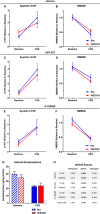Acute Pressor Response to Psychosocial Stress Is Dependent on Endothelium-Derived Endothelin-1
- PMID: 29453306
- PMCID: PMC5850198
- DOI: 10.1161/JAHA.117.007863
Acute Pressor Response to Psychosocial Stress Is Dependent on Endothelium-Derived Endothelin-1
Abstract
Background: Acute psychosocial stress provokes increases in circulating endothelin-1 (ET-1) levels in humans and animal models. However, key questions about the physiological function and cellular source of stress-induced ET-1 remain unanswered. We hypothesized that endothelium-derived ET-1 contributes to the acute pressor response to stress via activation of the endothelin A receptor.
Methods and results: Adult male vascular endothelium-specific ET-1 knockout mice and control mice that were homozygous for the floxed allele were exposed to acute psychosocial stress in the form of cage switch stress (CSS), with blood pressure measured by telemetry. An acute pressor response was elicited by CSS in both genotypes; however, this response was significantly blunted in vascular endothelium-specific ET-1 knockout mice compared with control mice that were homozygous for the floxed allele. In mice pretreated for 3 days with the endothelin A antagonist, ABT-627, or the dual endothelin A/B receptor antagonist, A-182086, the pressor response to CSS was similar between genotypes. CSS significantly increased plasma ET-1 levels in control mice that were homozygous for the floxed allele. CSS failed to elicit an increase in plasma ET-1 in vascular endothelium-specific ET-1 knockout mice. Telemetry frequency domain analyses suggested similar autonomic responses to stress between genotypes, and isolated resistance arteries demonstrated similar sensitivity to α1-adrenergic receptor-mediated vasoconstriction.
Conclusions: These findings specify that acute stress-induced activation of endothelium-derived ET-1 and subsequent endothelin A receptor activation is a novel mediator of the blood pressure response to acute psychosocial stress.
Keywords: cage switch stress; endothelin‐1; endothelium‐derived factors; psychosocial stress; stress; vascular endothelium‐specific ET‐1 knockout mice.
© 2018 The Authors. Published on behalf of the American Heart Association, Inc., by Wiley.
Figures






Similar articles
-
Increased endothelial exocytosis and generation of endothelin-1 contributes to constriction of aged arteries.Circ Res. 2010 Jul 23;107(2):242-51. doi: 10.1161/CIRCRESAHA.109.210229. Epub 2010 Jun 3. Circ Res. 2010. PMID: 20522806 Free PMC article.
-
Interleukin-10 attenuates vascular responses to endothelin-1 via effects on ERK1/2-dependent pathway.Am J Physiol Heart Circ Physiol. 2009 Feb;296(2):H489-96. doi: 10.1152/ajpheart.00251.2008. Epub 2008 Dec 12. Am J Physiol Heart Circ Physiol. 2009. PMID: 19074677 Free PMC article.
-
NFATc3 contributes to intermittent hypoxia-induced arterial remodeling in mice.Am J Physiol Heart Circ Physiol. 2010 Aug;299(2):H356-63. doi: 10.1152/ajpheart.00341.2010. Epub 2010 May 21. Am J Physiol Heart Circ Physiol. 2010. PMID: 20495147 Free PMC article.
-
Chronic ethanol intake modulates vascular levels of endothelin-1 receptor and enhances the pressor response to endothelin-1 in anaesthetized rats.Br J Pharmacol. 2008 Jul;154(5):971-81. doi: 10.1038/bjp.2008.157. Epub 2008 May 12. Br J Pharmacol. 2008. PMID: 18469849 Free PMC article.
-
Endothelin-1: Biosynthesis, Signaling and Vasoreactivity.Adv Pharmacol. 2016;77:143-75. doi: 10.1016/bs.apha.2016.05.002. Epub 2016 Jun 21. Adv Pharmacol. 2016. PMID: 27451097 Review.
Cited by
-
Endothelin receptor blockade blunts the pressor response to acute stress in men and women with obesity.J Appl Physiol (1985). 2022 Jan 1;132(1):73-83. doi: 10.1152/japplphysiol.00156.2021. Epub 2021 Nov 11. J Appl Physiol (1985). 2022. PMID: 34762528 Free PMC article. Clinical Trial.
-
Endothelin Modulates Rhythm Disturbances and Autonomic Responses to Acute Emotional Stress in Rats.Biology (Basel). 2023 Nov 5;12(11):1401. doi: 10.3390/biology12111401. Biology (Basel). 2023. PMID: 37998000 Free PMC article.
-
Elevated plasma endothelin-1 is associated with reduced weight loss post vertical sleeve gastrectomy.Surg Obes Relat Dis. 2019 Jul;15(7):1044-1050. doi: 10.1016/j.soard.2019.03.047. Epub 2019 Apr 9. Surg Obes Relat Dis. 2019. PMID: 31147283 Free PMC article.
-
SCD and asthma comorbidity: the potential role of adverse childhood experiences.J Sick Cell Dis. 2025;2(1):yoaf007. doi: 10.1093/jscdis/yoaf007. Epub 2025 Mar 4. J Sick Cell Dis. 2025. PMID: 40235828 Free PMC article.
-
Impact of Acute and Chronic Psychosocial Stress on Vascular Inflammation.Antioxid Redox Signal. 2021 Dec 20;35(18):1531-1550. doi: 10.1089/ars.2021.0153. Epub 2021 Sep 14. Antioxid Redox Signal. 2021. PMID: 34293932 Free PMC article.
References
-
- McEwen BS. Physiology and neurobiology of stress and adaptation: central role of the brain. Physiol Rev. 2007;87:873–904. - PubMed
-
- Treiber FA, Kapuku GK, Davis H, Pollock JS, Pollock DM. Plasma endothelin‐1 release during acute stress: role of ethnicity and sex. Psychosom Med. 2002;64:707–713. - PubMed
-
- Lee DL, Webb RC, Brands MW. Sympathetic and angiotensin‐dependent hypertension during cage‐switch stress in mice. Am J Physiol Regul Integr Comp Physiol. 2004;287:R1394–R1398. - PubMed
Publication types
MeSH terms
Substances
Grants and funding
LinkOut - more resources
Full Text Sources
Other Literature Sources
Medical

